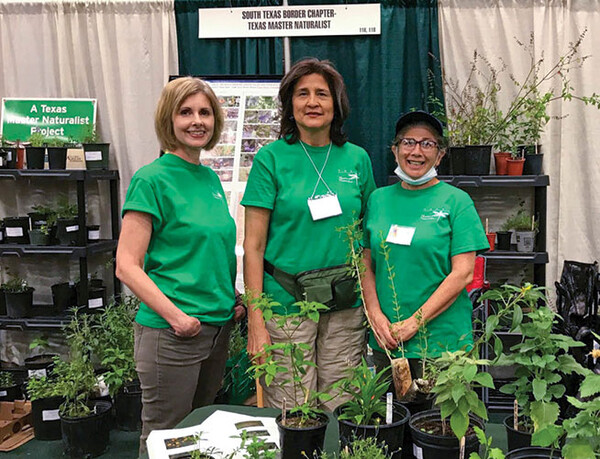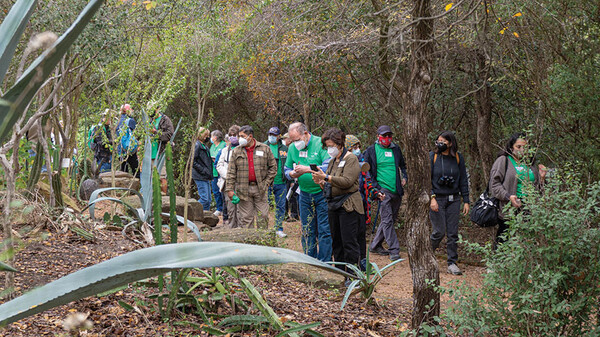 PHARR, TEXAS–The South Texas Border Chapter of Texas Master Naturalists honored 55 graduates at their first in-person ceremony since 2020. The new chapter members included 24 members who completed the program in 2020, 13 from the 2021 class and this year’s 18 new members.
PHARR, TEXAS–The South Texas Border Chapter of Texas Master Naturalists honored 55 graduates at their first in-person ceremony since 2020. The new chapter members included 24 members who completed the program in 2020, 13 from the 2021 class and this year’s 18 new members.
Texas Master Naturalists are volunteers; they are ordinary citizens from all walks of life. Locally, many are young adults who have jobs and careers, college students, retired members of the community and Winter Texans. Their desires are to learn about the local habitat and to help preserve the native vegetation of the Rio Grande Valley and the wildlife that depends on it.
The Texas Master Naturalist organization is sponsored by two state agencies: Texas Parks & Wildlife Department and Texas A&M AgriLife Extension Service and Texas Sea Grant. Local sponsors are Tony Reisinger, Cameron County Extension Agent for Coastal & Marine Resources with Texas Sea Grant at Texas A&M University and the Texas AgriLife Extension Service and Javier de Leon, Park Superintendent at Estero Llano Grande State Park - Texas Parks and Wildlife Department.
 To graduate and become certified, volunteers receive three months of classroom training taught by local university professors and agency field experts during weekly three-hour evening classes. Because of the global pandemic, training during the past two years was presented virtually.
To graduate and become certified, volunteers receive three months of classroom training taught by local university professors and agency field experts during weekly three-hour evening classes. Because of the global pandemic, training during the past two years was presented virtually.
As volunteers, Valley Texas Master Naturalists work with numerous area partners in various programs and capacity of community based conservation and outreach activities, from providing manual labor in helping to clear and maintain trails in federal and state parks, developing pollinator and specialty native plant gardens, leading nature tours, offering programs to organizations through their speakers' bureau, providing administrative assistance and joining coastal naturalist programs like turtle patrol and Red Tide Ranger and local, national and global citizen science projects; Master Naturalists advise cities, schools and other public entity personnel in helping them create natural habitat gardens that help sustain pollinators, insects, birds and other wildlife.
By virtue of being a Texas Master Naturalist, volunteer hours help the state in a unique monetary way. For each volunteer hour documented, it is valued at $28.54, an amount established by the Independent Sector group, an hourly amount that is recognized as a national standard. The amount is arrived by reaching across a broad spectrum of volunteer charitable activity and adjusted annually.
 The South Texas Border Chapter was established in 2015; it is open to residents over the age of 18 in Cameron, Hidalgo and Starr counties. Since 2015, South Texas Border Chapter volunteers have logged 43,644 volunteer service hours, generating more than $1.2 million that could be used toward in-kind 50/50 match in funded federal grant programs. Texas Parks and Wildlife park administrators apply for federal grants to support their parks, public recreational opportunities and educational programs; grants also help fund urban wildlife programs, Texas Nature Trackers, Texas Wildscapes, Wildlife Interpretive Program and the Texas Master Naturalist program.
The South Texas Border Chapter was established in 2015; it is open to residents over the age of 18 in Cameron, Hidalgo and Starr counties. Since 2015, South Texas Border Chapter volunteers have logged 43,644 volunteer service hours, generating more than $1.2 million that could be used toward in-kind 50/50 match in funded federal grant programs. Texas Parks and Wildlife park administrators apply for federal grants to support their parks, public recreational opportunities and educational programs; grants also help fund urban wildlife programs, Texas Nature Trackers, Texas Wildscapes, Wildlife Interpretive Program and the Texas Master Naturalist program.
There are 48 Master Naturalist chapters throughout Texas, comprising more than 15,200 volunteers who have logged 5.9 million hours to date. Their service in 2021 is valued at $10.18 million and more than $131.53 million since the state program’s inception in 1998.
Master Naturalists are trained to be stewards of their natural geographical environment and to teach these skills to others. There is a master naturalist program in every state.
As a community outreach, educational and recruiting opportunity, South Texas Border Chapter member and retired U.S. Navy Chief Journalist Anita Westervelt writes a nature column for the McAllen Monitor each first and third Saturday of the month. She writes a bimonthly blog on the chapter website that is available to the public. The chapter currently offers open meetings the third Monday of each month; meetings are free and held virtually. Classes to become a Texas Master Naturalist begin each January. Please navigate the chapter website to find more about what the chapter offers the community and how to become a member: www.stbctmn.org.













